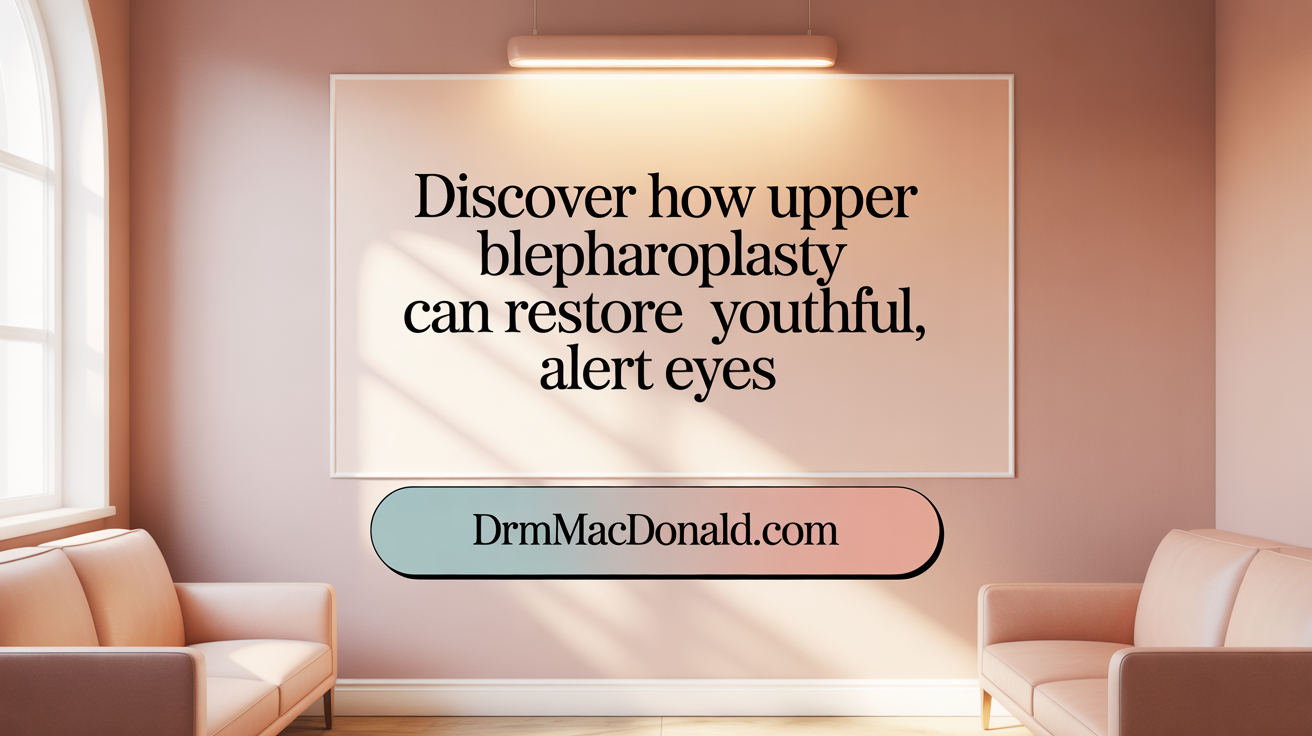Understanding the Impact of Hooded and Droopy Eyelids
Hooded and droopy eyelids not only affect facial aesthetics but may also impair vision and contribute to discomfort. Upper blepharoplasty, a surgical eyelid rejuvenation procedure, offers an effective solution to address these concerns. This article delves into the causes, treatment options, surgical process, recovery, and outcomes associated with upper blepharoplasty, helping readers make informed decisions about eyelid rejuvenation.
Causes and Symptoms of Hooded and Droopy Eyelids
 Hooded and droopy eyelids can develop for numerous reasons, often affecting both appearance and vision. Aging is one of the primary factors, as the skin loses its elasticity and muscles weaken over time, leading to sagging. Genetics also play a significant role, with some individuals being born with naturally heavier upper eyelids or less resilient skin.
Hooded and droopy eyelids can develop for numerous reasons, often affecting both appearance and vision. Aging is one of the primary factors, as the skin loses its elasticity and muscles weaken over time, leading to sagging. Genetics also play a significant role, with some individuals being born with naturally heavier upper eyelids or less resilient skin.
Beyond aging and heredity, various medical conditions can cause or contribute to drooping eyelids. These include muscle-related disorders such as myasthenia gravis, nerve damage from stroke or Horner syndrome, and tumors pressing on nerves or tissues around the eyes. Trauma or injury to the eyelids and surrounding structures can also result in sagging or drooping.
The most common symptoms linked with drooping eyelids or ptosis include a sensation of heaviness in the eyelids, decreased peripheral vision, blurred or obstructed sight, and overall tired-looking eyes. Some individuals may tilt their head or raise their eyebrows frequently to improve their view. Excess eyelid skin can cover part of the eye or pupil, affecting vision, especially in more severe cases.
In newborns, congenital ptosis is a condition present at birth that may block vision and require medical or surgical intervention. Whether caused by aging, genetics, or medical illness, addressing hooded or droopy eyelids involves evaluating the severity of symptoms and the underlying cause. Treatment options range from surgical procedures like blepharoplasty to address excess skin and fat, to treatments aimed at restoring muscle strength or nerve function in specific medical cases.
Upper Blepharoplasty: Definition and Benefits

What is upper blepharoplasty and how does it help with hooded and droopy eyelids?
Upper blepharoplasty is a popular surgical procedure designed to remove excess skin, muscle, and fat from the upper eyelids. During this operation, the surgeon makes a small incision within the natural crease of the eyelid, allowing access to remove or reposition tissue. This technique ensures that scars are hidden within the eyelid fold, making the results look natural.
The primary goal of upper blepharoplasty is to address hooded, droopy eyelids. As we age, excess skin and fat can sag over the eyes, causing a tired or aged appearance. This sagging may also obstruct peripheral vision, impairing daily activities.
By lifting and smoothing the eyelids, the procedure restores a more alert and youthful look. It also alleviates discomfort associated with heavy eyelids, such as eyelid heaviness and strain. Besides cosmetic improvements, upper blepharoplasty can significantly enhance functional vision when excess eyelid tissue blocks sight.
What are the advantages of this procedure?
- Removes excess skin, muscle, and fat to improve eyelid shape and contour
- Reduces hooded and droopy appearance for a more awake and lively look
- Restores peripheral vision in cases where sagging skin obstructs sight
- Smooths out wrinkles and fine lines around the eyes
- Provides long-lasting results—effects can last around ten years with proper care
- Boosts confidence by creating a more youthful and energized appearance
How does the recovery process support the benefits?
Most patients notice visible improvements within 10 to 14 days post-surgery. Swelling and bruising are common initially but gradually diminish. When performed by a skilled surgeon, the procedure yields natural-looking results that remain long-term, often boosting self-esteem and facial harmony for many years.
By combining functional benefits with aesthetic enhancements, upper blepharoplasty remains a favored choice for those seeking a refreshed, more youthful appearance and improved quality of life.
Candidate Selection and Preoperative Preparation
 Who is a suitable candidate for eyelid surgery and what preparation is needed?
Who is a suitable candidate for eyelid surgery and what preparation is needed?
Eyelid surgery, known as blepharoplasty, is typically suitable for healthy individuals facing excess eyelid skin, drooping, or fat deposits that hinder vision or affect appearance. Most candidates are over 35, but younger individuals with hereditary puffiness or drooping eyelids can also be good contenders.
To ensure the best outcome, proper medical evaluation is crucial. This includes comprehensive eye examinations, visual field testing, and photographic documentation of the eyelids and face. These tests help confirm that the eyelid issues are due to excess tissue rather than underlying health problems.
Pre-surgical instructions are important to minimize risks and promote healing. Patients are usually advised to stop taking blood-thinning medications such as aspirin, anti-inflammatory drugs, or herbal supplements about two weeks before surgery, as these can increase bleeding. Quitting smoking at least four weeks prior to the procedure is strongly recommended because smoking impairs blood flow and delays healing.
Patients should arrange for someone to drive them home post-operation. It’s also helpful to prepare their living environment for recovery by stocking up on comfort items like cold packs, lubricating eye drops, and loose clothing that does not require much effort to wear.
Choosing a qualified, experienced surgeon is critical. It’s best to select a board-certified plastic surgeon or ophthalmologist with specialization in eyelid procedures, ensuring safe surgery and natural results. Proper candidate selection and thorough preparation can significantly enhance the success of eyelid surgery.
Surgical Procedure and Techniques in Upper Blepharoplasty

What are the procedural steps and techniques involved in upper blepharoplasty?
Upper blepharoplasty, commonly known as eyelid lift surgery, involves several carefully executed steps to improve the appearance and function of aging or drooping eyelids. The procedure typically begins with detailed marking of the eyelid crease, generally placed 7 to 10 millimeters above the lash line. This guides the surgeon to make incisions along the natural eyelid fold, ensuring that scars remain hidden and results look natural.
Once the markings are in place, the patient receives local anesthesia combined with sedation. This anesthesia numbs the area and keeps the patient comfortable throughout the operation. The surgeon then makes a precise incision along the marked eyelid crease with either a scalpel or a laser device, creating a clean, controlled cut.
Following the incision, the surgeon carefully excises excess skin to eliminate sagging and droopiness. If necessary, partial removal or repositioning of orbital fat is performed to address puffiness or hollowing. The orbicularis muscle, responsible for eyelid movement, may be preserved or selectively trimmed based on the individual's specific needs and aesthetic goals.
Dissection continues through the orbital septum, allowing the surgeon to access and manage herniated fat. After completing the tissue adjustments, the incisions are meticulously closed with fine sutures that minimize scarring and maintain eyelid symmetry. Postoperative care involves applying cold compresses to reduce swelling, prescribing antibiotics to prevent infection, and closely monitoring for any complications.
This precise technique ensures that the results are long-lasting, natural-looking, and aligned with the patient’s facial features, helping achieve a more youthful, alert appearance.
Recovery Process and Post-Operative Care

What is the expected recovery timeline and post-operative care following upper blepharoplasty?
Recovery after upper blepharoplasty is generally a manageable process that lasts about one to two weeks. During this time, swelling and bruising are most noticeable but gradually improve, enabling most patients to return to work and light activities. The surgeon usually removes stitches between days 4 and 7. It’s important to avoid strenuous activities such as heavy lifting and vigorous exercise during this initial period.
Within the first week, swelling and bruising tend to decrease significantly. Patients may also experience some tightness or mild discomfort, which can be alleviated with prescribed medications. As healing progresses into weeks 2 and 3, swelling further diminishes, and most patients feel comfortable resuming normal daily routines, including light exercise, while monitoring for any unusual sensations or signs of complications.
Full and final healing often takes between three to six months. During this period, scars will continue fading and residual swelling will resolve. The skin around the eyes may appear temporarily tighter due to swelling but will relax as healing completes.
Post-operative care plays a crucial role in ensuring a smooth recovery. Daily protocols include applying cold compresses to reduce swelling, maintaining an elevated head position when resting or sleeping, and using eye drops or ointments as prescribed to keep the eyes moist and prevent infection. Protecting the eyes from direct sunlight with sunglasses and following the surgeon’s instructions on cleaning and care significantly enhances healing.
Adherence to post-operative guidelines helps minimize risks such as infection, dry eyes, or wound healing problems. While most patients return to their normal routines quickly, following all care instructions remains essential for achieving optimal aesthetic results and long-term satisfaction.
Risks, Complications, and Their Management
Eyelid surgery, or blepharoplasty, offers significant aesthetic and functional benefits, but like all surgical procedures, it carries potential risks and complications. Understanding these risks is important for patients and surgeons alike to ensure safety and successful outcomes.
Common and rare surgical risks
Common complications include bruising, swelling, dry eyes, and temporary vision disturbances, which generally resolve within a few weeks. More serious risks encompass infection, bleeding (hematoma), eyelid malposition such as ectropion or entropion, and potential injury to eye muscles or optic structures resulting in vision loss.
Less frequent complications include asymmetry, persistent dry or irritated eyes, wound healing issues, scarring, or eyelid continual drooping. Rare but serious risks involve orbital hemorrhage requiring emergency intervention, which could threaten vision if not promptly treated.
Symptoms and signs of complications
Recognizing early signs is critical. Symptoms of infection include increased redness, warmth, pain, or pus around the incisions. Hematoma presents as a painful, swollen eye that may discolor. Dry or itchy eyes, excessive tearing, or blurred vision can indicate exposure issues or nerve injury. Sudden vision loss, severe pain, or a tense, bulging eye demands immediate medical attention.
Preventative measures including surgeon selection
Selecting a board-certified surgeon with experience in eyelid procedures significantly reduces risk. Such surgeons possess detailed anatomical knowledge and surgical skill to minimize complications. Preoperative assessment helps identify factors like dry eyes, eyelid muscle strength, and overall eye health, guiding surgical planning.
Post-surgical monitoring and treatment of complications
Close postoperative monitoring allows early identification of issues. Patients should follow all care instructions—such as applying cold compresses, avoiding strenuous activities, and protecting eyes from sun and wind. Prompt management of complications includes antibiotics for infection, surgical correction for eyelid malpositions, and ocular lubricants for dryness.
In case of severe events like orbital hemorrhage, immediate measures such as canthotomy decompress the orbit to preserve vision. Regular follow-ups with the surgeon ensure proper healing, and any concerning symptoms should be addressed promptly to prevent long-term sequelae.
| Risk Type | Common Sign/Symptoms | Management Strategies |
|---|---|---|
| Infection | Redness, pus, persistent pain | Antibiotics, wound cleaning, possibly surgical intervention |
| Hematoma | Swelling, discoloration, pain | Evacuation if large, cold compresses, head elevation |
| Eyelid malposition | Ectropion or entropion, mirror deformities | Surgical revision to reposition eyelid |
| Vision loss | Sudden vision change, eye pain | Emergency decompression, immediate specialist care |
| Dry eyes | Persistent irritation, sandy sensation | Ocular lubricants, moisture chambers |
Choosing an experienced surgeon and adhering to postoperative care protocols are vital to mitigating risks and ensuring a safe healing journey. Understanding early warning signs can facilitate prompt action and improve the chances of successful, complication-free recovery.
Comparing Treatment Options and Visual Outcomes
What surgical and non-surgical treatment options are available for correcting hooded eyelids?
Treatments for hooded eyelids range from invasive surgeries to non-invasive procedures. Surgical options include blepharoplasty, where excess skin, fat, and loose tissue are carefully removed or repositioned to achieve a more alert and youthful appearance. This procedure offers lasting results, often around 10 years.
Non-surgical approaches include several minimally invasive techniques. Botox or other neuromodulators can relax muscles around the eyes, lifting the eyelids somewhat and opening the eyes. Dermal fillers, particularly in the temple and brow area, support the skin and improve eyelid contour.
Skin tightening treatments like laser resurfacing and plasma fibroblast therapy stimulate collagen, resulting in skin retraction. Additional options such as radiofrequency treatments, microcurrent devices, and FDA-approved eye drops like Upneeq temporarily lift the eyelids, providing short-term benefits.
The selection depends on the severity of hooding, patient health, and desired permanence. Surgical intervention is generally best for moderate to severe cases, offering a durable, long-lasting correction. Non-surgical options are suitable for mild cases or patients looking for temporary enhancement.
How do treatment options for hooded eyelids compare, and what criteria should guide selection?
While both surgical and non-surgical methods aim to refresh and lift the eyelids, they differ significantly in results and longevity. Blepharoplasty provides immediate, dramatic change by physically removing excess tissue, making it preferable for significant sagging or functional impairments like vision obstruction.
Non-surgical treatments, such as laser skin tightening, fillers, and topical agents, are less invasive with minimal downtime. They can improve fine wrinkles, skin laxity, and mild droopiness, but their effects tend to be temporary, lasting from months up to a few years.
Choosing the appropriate treatment depends on several factors:
- Severity of eyelid laxity
- Patient’s goals for appearance and function
- Overall skin quality
- Willingness to undergo surgery and recovery
- Whether temporary or permanent results are preferred
Consulting with a qualified ophthalmologist or plastic surgeon ensures an accurate assessment and a personalized plan that balances safety, effectiveness, and patient expectations.
Are there visual examples of before and after results for upper blepharoplasty and non-surgical treatments?
Yes, visual evidence showcases the effectiveness of both approaches. The website includes photos demonstrating significant improvements after upper blepharoplasty—droopy, hooded eyelids are corrected, revealing more open, alert eyes. The scars from surgical procedures are typically hidden within natural eyelid creases.
Similarly, before-and-after images of non-surgical treatments like dermal fillers show a lifting effect, filling hollows, reducing dark circles, and smoothing wrinkles. These photos help prospective patients visualize potential outcomes and set realistic expectations.
The longevity of results varies: surgical results can last up to a decade with proper care, while non-surgical corrections may require repeat treatments every 1 to 3 years. Both types of images serve as powerful tools for understanding what improvements are achievable through different methods.
| Treatment Type | Duration of Results | Invasiveness | Notable Advantages | Typical Cost (Approx.) |
|---|---|---|---|---|
| Blepharoplasty | 5-10 years or more | Surgical, more invasive | Long-lasting, functional and cosmetic improvement | $2,500 - $5,000 |
| Botox/Neuromodulators | 3-6 months | Minimally invasive | Quick, temporary lift, minimal downtime | Around $379 (2019 data) |
| Dermal Fillers | 1-3 years | Minimally invasive | Adds volume, improves eyelid contours | $625 - $850 |
| Laser Resurfacing | 1-3 years | Non-invasive | Skin tightening, wrinkle reduction | ~$2,200 |
| Plasma Fibroblast | Up to 3 years | Minimally invasive | Skin tightening, minimal downtime | Varies |
Visual improvements in eyelid appearance depend on the chosen method and individual conditions, but both surgical and non-surgical treatments can significantly enhance your look and confidence.
Making an Informed Choice for Eyelid Rejuvenation
Upper blepharoplasty stands as a definitive and effective procedure for those seeking solutions to hooded and droopy eyelids, combining aesthetic enhancement with improved visual function. Understanding the causes, candidacy requirements, surgical techniques, recovery expectations, and potential risks empowers individuals to consult confidently with qualified specialists. Complementary non-surgical options provide alternatives or adjuncts depending on individual needs and severity. Ultimately, whether opting for surgical or non-invasive treatments, personalized care and expert guidance are key to achieving natural, lasting results that restore youthful vitality to the eyes.
References
- Seven upper eyelid surgery Q&A - Mayo Clinic Health System
- 9 Ways to Lift Hooded Eyelids, According to Dermatologists - Byrdie
- Blepharoplasty (Eyelid Lift) - Canadian Society of Plastic Surgeons
- Hooded Eyes Makeover: Explore Blepharoplasty for a Fresh Look
- Achieving Natural Look: Blepharoplasty for Hooded Eyes
- Upper Blepharoplasty in Montreal | Clinique-K
- Blepharoplasty (Eyelid Surgery): What It Is, Details & Recovery
- Best Eyelid Surgery (Blepharoplasty) | Plastic Surgeon in Toronto
